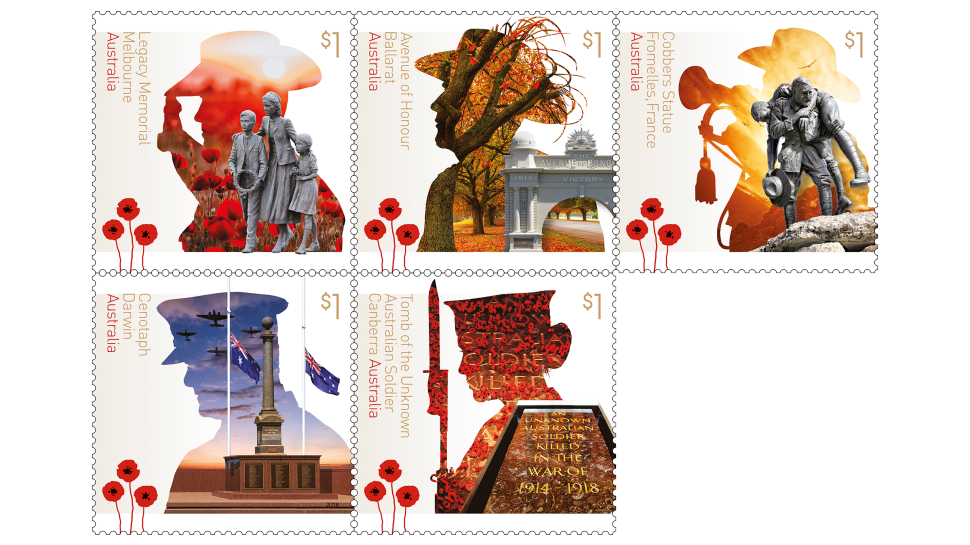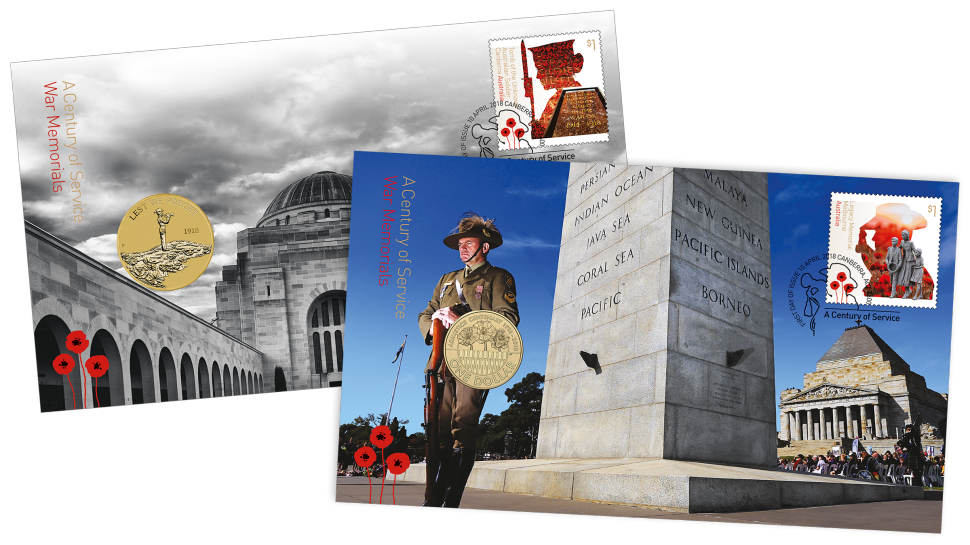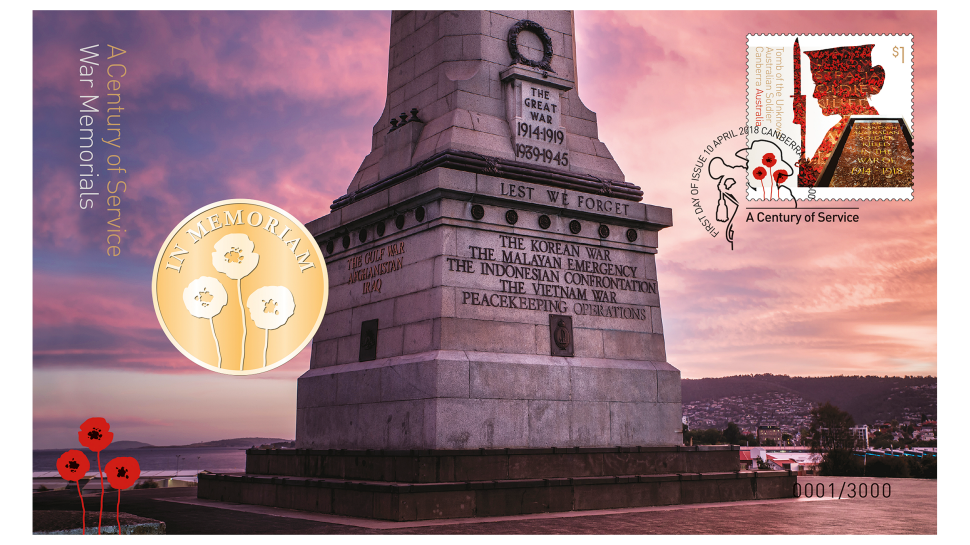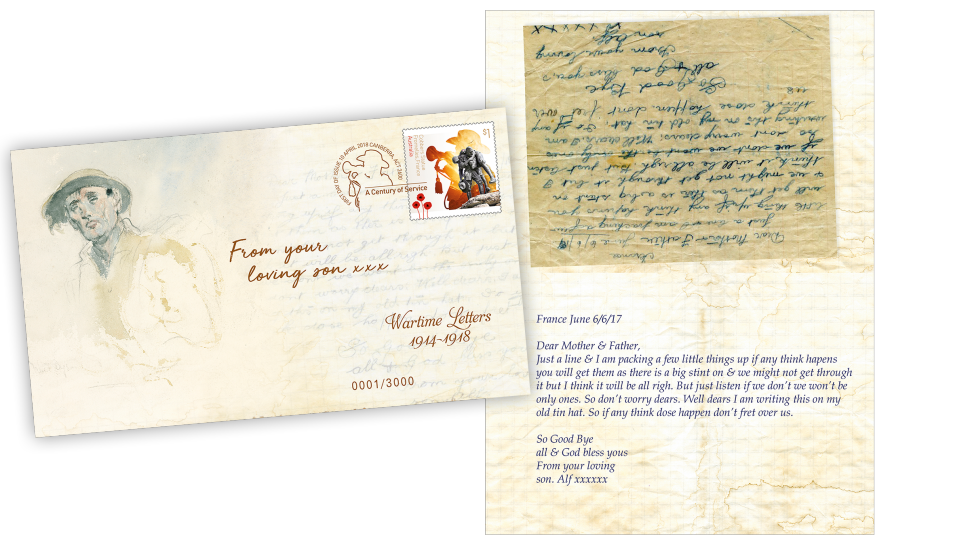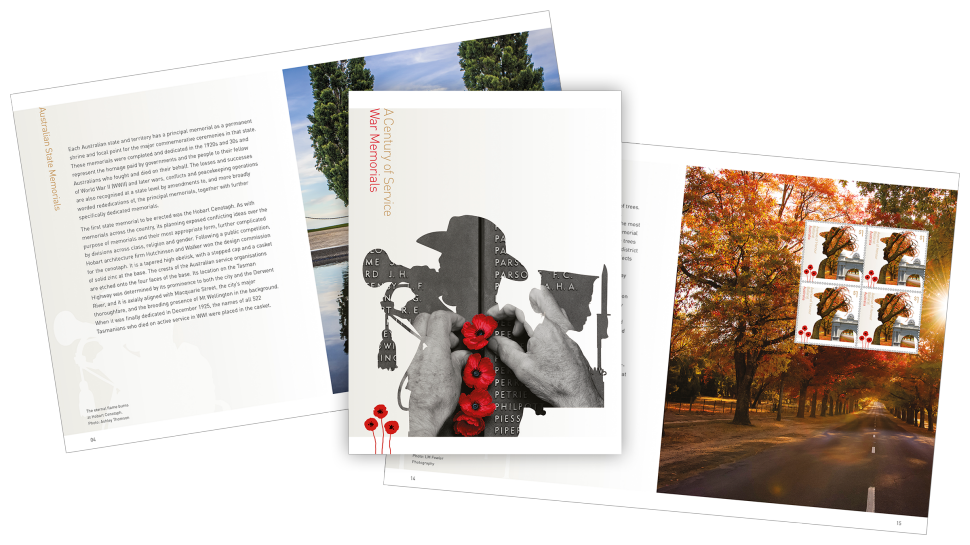The Century of Service stamp series presents the Australian experience of war across the last century. Previous issues are Tri-services (2014), War Animals (2015), Vietnam War (2016) and Women in War (2017).
The latest issue is War Memorials, released on 10 April 2018. It focuses on the various forms war memorials take and the different ways in which they express mourning and remembrance. The stamps presents four important war memorials from around Australia and one from overseas: Cobbers Statue, Fromelles, France; Avenue of Honour, Ballarat; Tomb of the Unknown Australian Soldier, Canberra; Darwin Cenotaph; and Legacy Memorial, Shrine of Remembrance, Melbourne.
Origin and form
War memorials sprang up across Australia following the huge losses sustained in World War I (WWI), where more than 60,000 Australians died. The memorials were driven in part because people could not visit the gravesites of the dead. A public memorial stands as a symbol of the graves of all who died so far from home. For this reason, many memorials have been located in prominent and accessible locations and they quickly became the focus for community Anzac Day and Remembrance Day services.
War memorials take many forms, from simple memorial plaques and honour rolls to grand museums and monuments. They also include functional forms such as gardens, pavilions, swimming pools, halls, hospitals, churches and bridges (the Anzac Bridge in Sydney, the longest cable-stayed bridge in Australia, is a memorial to Australians and New Zealanders who served in WWI). Regardless of their form, common to all is the intention to recognise, remember and learn about the profound loss caused by war. There are memorials dedicated to all who have served and others dedicated to all who have died. There are memorials focusing on particular wars, battles, campaigns or events, and others dedicated to those who served or died from a town or region. There are memorials to Australians sited near the battlefields where many fell, or at prisoner of war camps or where units were or are based.
National and state
The Australian War Memorial in Canberra, dedicated in 1941, serves as the centre for national commemorations and helps shape the way Australians remember, interpret and understand the Australian experience of war and its enduring impact on society. Each Australian state and territory also has a principal memorial that serves as a permanent shrine and focal point for the major commemorative ceremonies in that state. These memorials were completed and dedicated after the end of WWI, in the 1920s and 30s, and represent the homage paid by the governments and the people to their fellow Australians who fought and died on their behalf. The losses endured in WWII and later wars and conflicts have been added to these principal memorials.
The regions and beyond
There are so many memorials in regional towns and cities across Australia that the country has been called a “nation of small town memorials”. Cenotaphs (literally “empty tomb”) and obelisks are common, as are “Digger memorials”, which are generally statues representing the rank and file soldier. A fine example of this latter form is the digger soldier by Margaret Baskerville in Alexandra.
A number of war memorials dedicated to Australian losses in war can be found in other countries, including at Gallipoli in Turkey, Passchendaele in Belgium, Fromelles and Villers-Bretonneux in France, in Papua New Guinea, in Thailand and in other parts of the globe where Australian forces have served.
The service of women
Women, too, have been recognised for their service through public memorials. More than 3,000 Australian civilian nurses volunteered for active service during WWI. The women worked in hospitals, on hospital ships and trains, and in casualty clearing stations closer to the front line. They served in locations from Britain to India, taking in France and Belgium, the Mediterranean and the Middle East. Many of them were decorated, with eight receiving the Military Medal for bravery. Twenty-five died during their service. The central figure in the southern windows in the Hall of Memory at the Australian War Memorial is titled “Devotion” and features a nurse with the Red Cross as the symbol of charity.
Aboriginal and Torres Strait Islander people
Aboriginal and Torres Strait Islander people have served in every conflict and commitment involving Australian and colonial forces, including both world wars, despite the fact that they were not eligible to vote until 1962 and were not included in the census until 1967. Yet for many years Indigenous men and women faced continuing discrimination and were often refused entry to Returned and Services League (RSL) clubs. Today, their service and sacrifice is increasingly acknowledged in special public memorials to Indigenous servicemen and servicewomen, including the first such memorial, located in Adelaide adjacent to the Torrens River, and a memorial in Sydney’s Hyde Park. Two regional examples are the memorial dedicated to Australian Indigenous war veterans at Toomelah, New South Wales, and a plaque at the Moree cemetery.
Special products
Some very special War Memorials products have been released for collectors and anyone interested in Australia’s wartime history:
Postal numismatic covers
These attractive postal numismatic covers feature striking photography. One cover presents the $1 Tomb of the Unknown Australian Soldier stamp, together with a Perth Mint $1 uncirculated coin with a “Lest we Forget 1918” bugler design. The second cover features the $1 Legacy Memorial stamp, together with a Royal Australian Mint $1 uncirculated coin that commemorates the 1918 Armistice, which brought World War I to a close.
Medallion cover
The War Memorials medallion cover presents the $1 Tomb of the Unknown Australian Soldier stamp, together with an “In Memoriam” gold-plated medallion that features a poppy design. The cover design includes a striking photograph of the Hobart Cenotaph, the first state memorial to be erected in Australia.
Prestige cover
This prestige cover focuses on the theme of “war letters” – heartfelt letters written between soldiers and their loved ones during World War I. The cover includes the $1 Cobbers Statue stamp, which presents this poignant memorial to Australian soldiers, located in Australian Memorial Park at Fromelles, France. The cover also includes an extract from a letter written by Australian Private Alf Clarke to his parents in Tasmania. Alf Clarke served in the 40th Battalion on the Western Front. He died in Flanders, Belgium on 7 June 1917, just one day after penning the letter.
Prestige booklet
This attractive prestige book includes detailed information about the history of memorialisation of war in Australia, as well as information about individual memorials including those featured on the stamps. There are five stamp pages, presenting each stamp from the issue in a block of four. Stunning and evocative colour photographs appear throughout.
The Century of Service: War Memorials stamp issue is available from 10 April 2018, online, at participating Post Offices and via mail order on 1800 331 794, while stocks last.
View the gallery and technical details from this issue
This article was produced at the time of publication and will not be updated.

